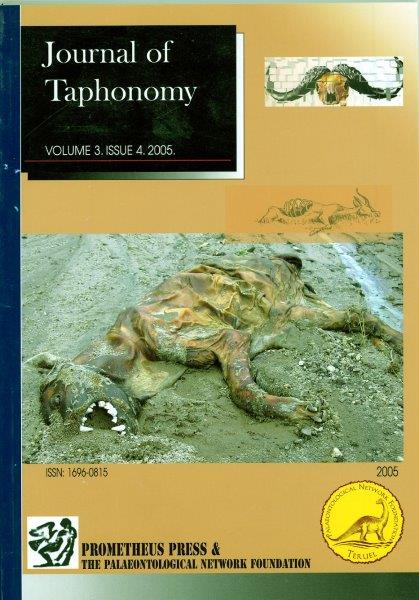
A Methodology for the Intraspecific Assessment of Heterogeneously Worn Hypsodont Teeth Using Computerized Tomography.
Justin W. Adams
Keywords: COMPUTERIZED TOMOGRAPHY, OCCLUSAL WEAR, METRIDIOCHOERUS, FAUNAL IDENTIFICATION
Computerized tomography (CT) has been used to address many diverse issues within several subfields of paleontology since its development in the 1970s. Here, an extension of CT based paleontological analysis is described that applies this technology intra-dentally in an attempt to mediate some of the difficulties posed in directly comparing hypsodont dental specimens that exhibit differing degrees of occlusal wear. As a case study, this report describes the use of CT scans to produce virtual occlusal wear on several third molar specimens of the extinct suid, Metridiochoerus andrewsi, from the Gondolin GD 2 South African Plio-Pleistocene faunal assemblage. The GD 2 assemblage has yielded a number of M. andrewsi third molar specimens, including several that exhibit only superficial occlusal wear which limits assessment of their occlusal morphologies. The resulting CT scanned teeth from the GD 2 assemblage are compared both to other more heavily worn third molar specimens from the GD 2 deposits, as well as to M. andrewsi third molar specimens from the Swartkrans Member 1 assemblage. Results indicate that once the appropriate CT slice level has been selected, individual specimens exhibiting essentially any occlusal wear stage can be directly compared to one another. The methodology described here has applications for virtually any taxonomic group with hypsodont dentitions and will provide a useful tool for more accurate specimen identifications, for assessing changes and intraspecific variation in occlusal surface morphology throughout wear, and for potentially understanding the variation, evolution and functional significance of hypsodont dental morphologies among certain taxa.
Dragging and Scattering of Camelid Bones by Fluvial Action in the Real Grande Gorge, Province of Catamarca, Southern Argentinean Puna.
Atilio Nasti
Keywords: VERTEBRATE TAPHONOMY, BONE SCATTERING, FLUVIAL ACTION, HIGH DESERT
Research carried out in the southern sector of the Puna de Atacama, Argentina, enables taphonomic hypotheses concerning bone scattering and the fossil record to be tested. To that end, this study is based on bone samples from modern camelid (Lama sp.) carcasses. In the first stages of research I evaluated the role played by disarticulation and fluvial transport in relation to different skeletal elements. Subsequently, I tested the various sedimentary contexts where the bones were buried and their relative importance in the different topographic localities. In certain areas of the vega hydraulic transport power decreases in relation to certain topographic accidents and patches of vegetation that act as a retaining wall. The reduction of this form of transport produces bone sedimentation. As such, there is the possibility of elaborating certain expectations, when possible, for the formation of a future fossil record in some sectors of this environment. Without underestimating the importance of previously developed fluvial bone transport models, my research favours a model in which some skeletal parts are more affected by transport than others, allowing us to determine the existence of different patterns of bone scattering and fossil assemblage in this area. In brief, this article produces preliminary empirical evidence for fluvial transport of camelid bones in the high desert, evidence which could be used as an indicator of original conditions in environments where bones were accumulated and became fossilized.
Taphonomic History of the Middle and Upper Palaeolithic Faunal Assemblage from Ortvale Klde, Georgian Republic.
Guy Bar-Oz, Daniel S. Adler.
Keywords: TAPHONOMY, ZOOARCHAEOLOGY, CAUCASUS, NEANDERTHALS, MODERN HUMANS, SUBSISTENCE, MIDDLE-UPPER PALAEOLITHIC, CAPRA CAUCASICA
We present the results of a detailed taphonomic and zooarchaeological study of the faunal remains from the late Middle Palaeolithic (LMP) and early Upper Palaeolithic (EUP) bone assemblage of Ortvale Klde, Georgian Republic. A series of taphonomic tests and analyses are employed to reconstruct the depositional history of the bone assemblage and investigate LMP (Neanderthal) and EUP (Modern human) hunting and subsistence strategies. We identify the maximum number of skeletal elements, document bone surface modifications, the mode of bone fragmentation, and the demographic structure of the main hunted ungulate population. The assemblage is characterized by significant density-mediated biases, yet in situ attrition and carnivore damage play a minimal role in assemblage formation. Data suggest that most bone destruction occurred during site occupation, probably in relation to marrow consumption as indicated by the mode of bone fragmentation. Caucasian tur (Capra caucasica) is the major prey species throughout the LMP and EUP, and body part representation, the absence of selective transport, and butchery marks from all stages of carcass processing suggest that Caucasian tur were subjected to extensive handling. Analysis of Caucasian tur dental eruption and wear indicates that prime-age adult individuals dominate the assemblage. The results of this study, the first zooarchaeological and taphonomic study carried out on a Palaeolithic bone assemblage from the southern Caucasus, indicates that hunting strategies and meat processing behaviors were not significantly different between Neanderthals and Modern humans.

